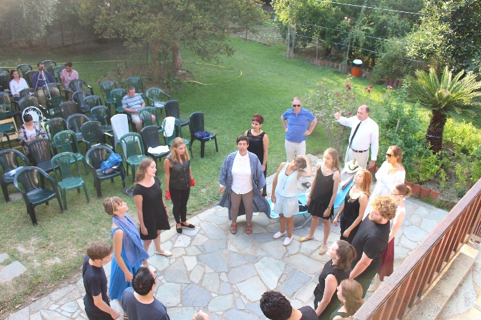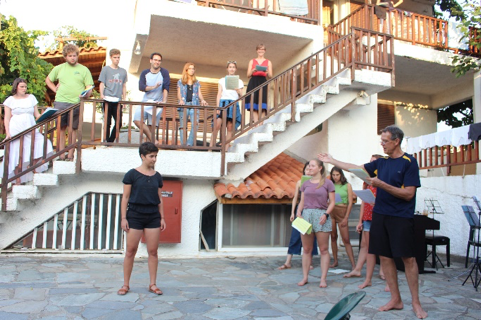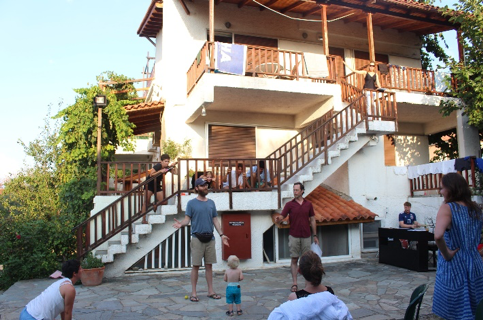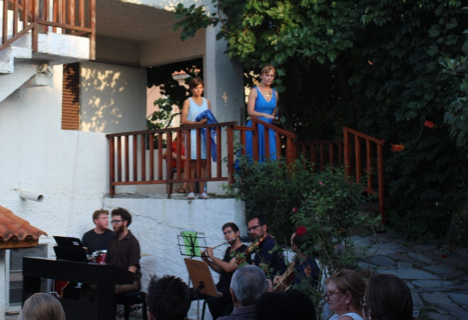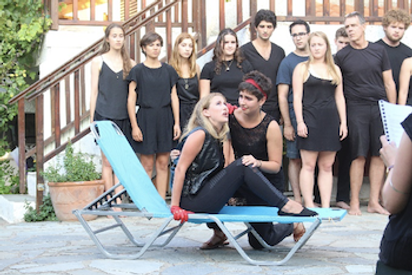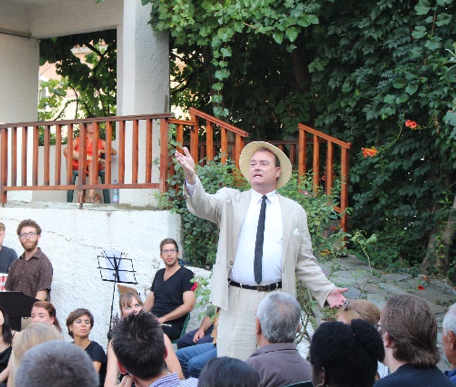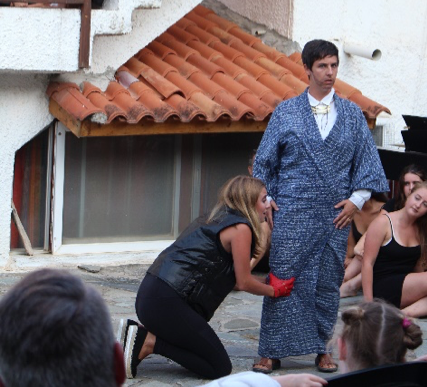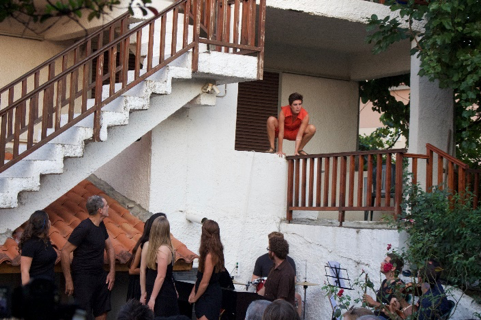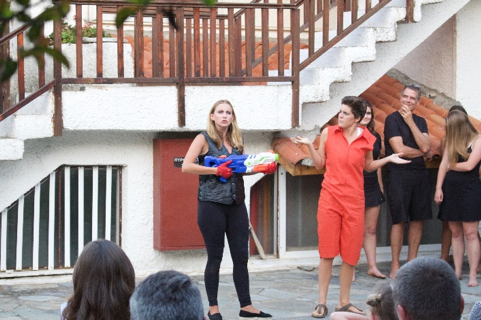Euripides' Orestes
Directed by Claire Catenaccio (Georgetown University)
August 17, 2018
Hellenikon Idyllion
Selianitika, Greece
For the Paideia Institute’s Living Greek in Greece program
Reviewed by Richard Hutchins
University of Miami
For two weeks every August, the Paideia Institute’s Living Greek in Greece program brings enthusiastic students of Ancient Greek to the Hellenikon Idyllion, a hotel that doubles as a cultural center for Ancient and Modern Greek, Classical music, and German culture, located in the charming village of Selianitika, Greece. Living Greek in Greece is a summer course in which students read Ancient Greek texts and discuss them in Ancient Greek. This past summer the text for the course was Euripides’ Orestes, which the students performed in the Hellenikon Idyllion for the village of Selianitika and fellow students. This production of the Orestes was directed by Claire Catenaccio, Assistant Professor of Classical Studies at Georgetown University.
Left: Claire Catenaccio directs practice of the Chorus. |
Right: Barry Brinker addresses Luby Kiriakidi. |
The Orestes was a work of Euripides’ old age and one of the most popular plays in antiquity.1 Unfortunately, it is rarely read or performed today. This production of the Orestes was particularly challenging, since Catenaccio only had had two weeks to produce it, and most of the students’ time was devoted to two spoken Ancient Greek classes during the day and trips to classical sites and performances on the weekend. To prepare the production in time, Catenaccio pared down the 1693-line text of the Orestes to an 835-line performance script, a much more manageable amount of Ancient Greek for students to memorize and perform in the allotted time. The Orestes itself can be be divided into two halves. The first half deals with Orestes’ madness and is an intense meditation on the psychology of guilt.2 The second half begins at line 1069, where Pylades yells ἐπίσχες (“stop!”) to rouse Orestes and Electra from their passivity—from which point the play increasingly resembles a revenge tragedy. The Orestes is thus an assemblage of deliberately incongruous scenes and moods.3 The question for any director is whether to unify the parts of the play or to let the differences shine.
Left: Catenaccio oversees practice of the finale |
Right: Helen (Patsy Craig) enters with Hermione (Figen |
Catenaccio’s Orestes let the differences shine. Each scene worked as an independent whole that, when viewed in succession, created a sense of realism within each scene but of surrealism overall. Catenaccio’s production began with a Hamlet-like Orestes paralyzed by guilt and self-consciously horrified at his madness. This Orestes, played by Solveig Gold, wore a red glove to signal his recent murder of Clytemnestra and black clothing to indicate mourning. Orestes’ main emotion in this portrayal was horror at the awakening knowledge of his guilt. Throughout the prologue, this Orestes was bound by mental illness to a lounge chair from which he would leap with an imaginary bow in hand to attack illusory Erinyes. While there is a debate in classical scholarship about whether a real or imaginary bow was used in the original production of the Orestes in 408, Catenaccio had this Orestes mime an imaginary bow to underscore his mental illness.4 Orestes was attended by a deeply caring Electra, played by Luby Kiriakidi, who opened the performance with a monody in the style of Modern Greek lament, and was perfectly attuned to Orestes’ shifting moods, gestures, facial expressions, and even tone of voice throughout the prologue. The decision for Orestes and Electra to mirror each other’s emotions so closely was developed by the two actors in daily rehearsal, and was intended to underline the intense intersubjectivity and even possible incest between brother and sister.
Later in the production, Orestes and Electra were accompanied by Pylades, played by Max Norman and dressed Mad Max style, wearing dark sun glasses and armed with a Super Soaker—a ridiculous sight. Outfitting Pylades as an outlaw foreshadowed his status in the second half of the play as the ringleader of the revenge plot. The choice to arm him with a squirt-gun, however, was due to the actors’ chance discovery of one on the premises of the Idyllion. The toy weapon, nonetheless, helped to underline the incongruity of Pylades as a tragic but also unconsciously comic figure. During the performance, the Super Soaker was hidden in a fire closet at the back of the stage, to be discovered by Pylades just as the revenge plot began in the second half of the play. This was a metatheatrical moment, as Pylades broke character by turning to the audience to smile at the absurdity of acting in a play in which water guns are discovered in fire closets just when needed.
Left: Solveig Gold as Orestes and Luby Kiriakidi as Electra. |
Right: Grace Stinson and Sydnie Chavez lead the Chorus. |
In the second act, the moroseness of the prologue shifted to comedy with the entrance of Menelaus, dressed as a conniving fop just returned from Troy. This Menelaus, played by Rachel Lesser, had not yet mentally awakened from his dream of luxury in the East. And yet, he used his aloofness from events in Argos to political ends, to get Orestes out of the way so as to inherit the kingdom of Argos. In this scene, Orestes expects Menelaus to defend him from the enraged δῆμος of Argos, in return for his father Agamemnon’s earlier help in the expedition to Troy. Lesser presented a Menelaus whose pose of detachment was clearly part of a waiting game, to hold off Orestes for as long as possible by neither committing to help him nor completely breaking ties with him. His evasiveness was interrupted by the entrance of a hot-blooded Tyndareus, played by Joe Garnjobst. Garnjobst presented Tyndareus as an idealistic defender of the νόμος, and he dressed the part by wearing a bright Seersucker suit, hat, and black armband to indicate mourning (457–8). He fumed onto the stage from his seat in the audience to prosecute Orestes for killing Clytemnestra, Tyndareus’ daughter.5 The emotional incongruity between the calculated aloofness of Menelaus as played by Lesser and the blunt anger of Tyndareus as played by Garnjobst resulted in a comedy of errors, as each foiled the other’s purposes with Orestes. As Tyndareus became angrier at Orestes, Menelaus became increasingly discomfited. The subtlety of Menelaus’ plot to appease Orestes while not committing himself to help him was gradually foiled by Tyndareus’ blunt prosecution.
Left: Joe Garnjobst as Tyndareus appeals to the νόμος |
Right: Rachel Lesser as a shrewdly aloof Menelaus. |
The second half of the play is a train-wreck of nonstop action, all centered around the wayward desire to kill Helen. Into the midst of this revenge plot drops, literally out of the sky, the Phrygian slave and his hilarious monody, the longest in Greek tragedy, played by Cat Lambert. As M. L. West has commented, “there is no funnier scene in Greek tragedy.”6 Lambert emphasized the polysemous nature of the Phrygian slave, himself a symbol of the incongruous, tragi-comic nature of Catenaccio’s Orestes as a whole. The Phrygian enters the very contemporary Argos of the Orestes as a final, farcical representative of the lost heroic age of Troy. He is not only temporally out of sync with Argos but linguistically as well, since his song is at times virtually incomprehensible. As a eunuch, “barbarian,” and slave, the Phrygian bears traces of femininity, and may represent a comic version of the Trojan prophet Cassandra from Aeschylus’ Agamemnon, herself, like the Phrygian slave, brought to Argos as a captive from Troy.7 In Catenaccio’s Orestes, the Phrygian served as a lighthearted foil to the cold and consistently violent Orestes of the second half of the play. We are told in a scholion to line 1366 that in the original production of the Orestes in 408, the Phrygian entered the stage by leaping from the σκηνή roof, just at the moment when the chorus was expecting the dead body of Helen to be wheeled out on the ἐκκύκλημα, not an operatic Phrygian.8 Catenaccio had Lambert imitate this moment in the original production by dressing him in an orange jumpsuit, as if he were a prison inmate or captive, for his leap from the banister of the first floor of the Idyllion onto the stage. Lambert then broke out into a monody composed in the style of the “New Music.” This monody was adapted for this performance to the style of a Gilbert and Sullivan patter song, with intervals of opera recitative, by Musical Director Joe McDonough. McDonough’s general idea was to create music that would keep the rhythm and pitch accent of the Greek, while being flexible enough to allow for different acting choices, and yet simple enough to be sung in combination with “word-painting,” i.e. when the actor musically illustrates the actions of the text. McDonough’s choral melodies were necessarily simpler than the monodies, because they needed to be learned by a larger group of students.
Left: Cat Lambert, as the Phrygian slave, leaps onto the stage. |
Right: the Phrygian slave befuddles Orestes. |
The Orestes famously ends with Apollo descending ex machina to unravel the chaos that the three desperadoes, Orestes, Pylades, and Electra, have created by the end of the play. Here, the Hellenikon Idyllion itself became important, as it offered three levels for Apollo to display his dominance, retaking control of the play at every level of the theatrical space: ground-level stage, mezzanine-level balcony, and upper story. At the start of the performance, Catenaccio had a beach towel with ominous eyes hung from the upper story of the Idyllion to represent Apollo’s overseeing of events throughout the play. Like the Super Soaker, the beach towel was simply found on the premises. Nonetheless, it worked well to hint at Apollo’s control of events throughout the play, while being just the kind of absurd object to foreshadow Apollo’s absurd epiphany in the finale.
In the finale of the performance of the Orestes that the students travelled to see in Patras, produced by the National Theatre of Northern Greece, the director himself, Yannis Anastasakis, suddenly appeared in the audience under a spotlight with a microphone to give Apollo’s last orders. Catenaccio also had Apollo break the fourth wall in her production by addressing the audience directly, Catenaccio revealing the god to be less a character in the play than a divine director who had been overseeing events all along. Catenaccio, however, had not one but three Apollos appear in the finale—two on stage (Jason Pedicone and Eric Hewett) and one on the top floor (Marissa Porter). This triple epiphany emphasized both the metatheatricality and the multiple possible meanings of Apollo in the final scene. The three Apollos, in the various levels of the theatrical space, showed the god reclaiming the theater in its entirety as his domain, a space which Orestes, Pylades, and Electra had commandeered over the course of the play. As a final comic gesture, actors shot confetti guns from the top floor of the Idyllion. Catenaccio thereby turned the finale into a celebration of the tragi-comic absurdity of the production as a whole.
But even Catenaccio was unprepared for the pièce de résistance, when the absurdity of reality itself burst all theatrical illusions, as Amos, a dog, careless of every propriety of the theater, took advantage of an open door in the changing room on the top floor of the Idyllion to trot triumphantly down the stairs and across the mezzanine—where an already nervous Electra, Orestes, Pylades, and Hermione were startled by this further epiphany—all the way to ground level, where, victorious, Amos found his master, Jason Pedicone, dressed as Apollo and giving his final orders to the conspirators. As if on cue, the Chorus then broke into a beautiful rendering of the play’s concluding hymn to Victory: ὦ μέγα σεμνὴ Νίκη. So, in the end, the dog eclipsed the god.9
Left: Electra, Orestes, and Pylades threaten to burn down |
Right: the triple epiphany of Apollo, after the confetti gun and |
Footnotes
1C. W. Willink, Euripides: Orestes, Oxford: Clarendon Press, 1986, pp. lxiii–lxiv; and W. G. Arnott, “Tension, Frustration, and Surprise: a Study of Theatrical Techniques in Some Scenes of Euripides’ Orestes,” Antichthon, 1983, pp. 13–28.
2F. M. Dunn, “Tragic and Comic License in Euripides’ Orestes,” Classical Antiquity, 1989, p. 250; and E. M. Blaiklock, The Male Characters of Euripides, Wellington, 1952, p. 180 ff.
3 For positive evaluations of the experimental nature of the Orestes, see Dunn 1989, pp. 239–240, 247–8.
4Willink 1986, p. 130; and West 1987, p. 200.
5D. J. Cronacher, Euripidean Drama: Myth, Theme, and Structure, University of Toronto Press, 1967, pp. 213–224, especially pp. 219–220.
6West 1987, p. 283.
7Froma Zeitlin, “The Closet of Masks: Role-Playing and Myth-Making in the Orestes of Euripides,” Ramus, 1980, pp. 51–77.
8E. Schwartz, Scholia in Euripidem I, Berlin, 1887, p. 217.
9I would like to thank Ilias Kolokouris, Sarah Gianakon, and the editor at Didaskalia for suggesting corrections to this review. I would also like to thank the Living Greek in Greece teachers—Claire Catenaccio, Joe Conlon, Anna Conser, Darrel Janzen, Cat Lambert, and Alex Petkas—as well as the musical director Joe McDonough. Most importantly, I would like to thank the LGiG students for working so hard to put on this performance of Orestes in Ancient Greek.

